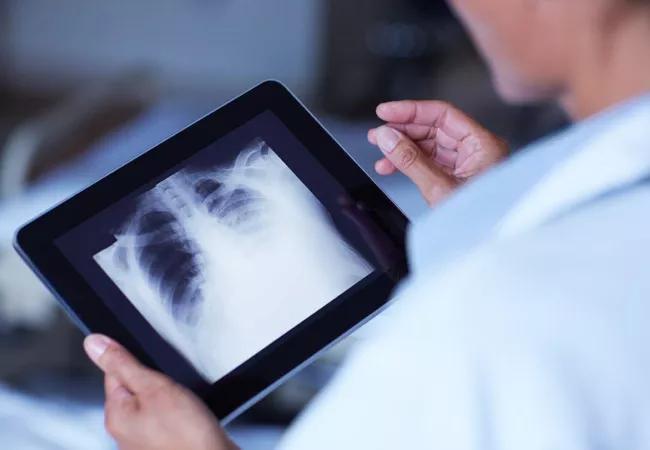Written by Amy Attaway, MD
Advertisement
Cleveland Clinic is a non-profit academic medical center. Advertising on our site helps support our mission. We do not endorse non-Cleveland Clinic products or services. Policy
Chronic obstructive pulmonary disease (COPD) is the fourth most common cause of death in the United States.1 Sarcopenia, or skeletal muscle loss, affects 20%-40% of COPD patients.2-4 It is a major comorbidity that impacts survival and physical function in COPD patients.5-9
We have previously demonstrated in the Nationwide Inpatient Sample that sarcopenia (defined by billing codes) is associated with increased risk for mortality (adjusted odds ratio [adj OR]: 2.1, 95% confidence intervals [CI]: 1.9-2.2) and higher healthcare costs (approximately 84% greater cost of hospitalization).10 As illustrated in the figure below, we have also demonstrated in our Cleveland Clinic population of COPD patients referred for lung volume reduction that reductions in the pectoralis muscle cross-sectional area are associated with disease progression in COPD (i.e., mortality, need for lung volume reduction or need for lung transplant).11 However, despite sarcopenia being a major problem for patients with COPD, the underlying mechanisms that cause sarcopenia remain poorly understood.12 Because of this, typical strategies to improve sarcopenia, including pulmonary rehabilitation and nutritional therapies, do not consistently improve outcomes for COPD patients.13
Why we care about hypoxia
The reason that COPD patients develop skeletal muscle loss is likely multifactorial and includes factors such as poor nutrition, aging, systemic inflammation and medications (i.e., corticosteroids).14 One of the areas in which we have focused our studies is the impact of hypoxia on skeletal muscle loss. While previous studies focused on the impact of continuous hypoxia on skeletal muscle loss, continuous hypoxia is a condition that is routinely screened for and treated in COPD patients per established guidelines.15 A more clinically relevant form of hypoxia that COPD patients routinely experience is a cycling of hypoxia/normoxia where COPD patients have normal oxygen saturation during the day but develop hypoxia while they are sleeping. Between 27% and 70% of COPD patients experience low oxygen saturation in the blood during sleep,16-18 and hypoxia can occur throughout sleep.19
Observational studies have demonstrated an increased risk for mortality due to nocturnal hypoxia;20 however, randomized controlled trials have not demonstrated a survival benefit from nocturnal oxygen supplementation.21-23 Because of this, current guidelines do not recommend screening for or treating nocturnal hypoxia unless patients report symptoms of poor sleep or have evidence of comorbidities such as pulmonary hypertension.24 However, other studies have suggested that nocturnal hypoxia may contribute to sarcopenia in COPD as demonstrated by: reductions in exercise work rate,25 six-minute walk test,26 skeletal muscle contraction of the diaphragm27 and overall increased systemic inflammation.28
A three-pronged approach to sarcopenia and future directions
Our approach to determining whether nocturnal hypoxia contributes to sarcopenia in COPD is three-pronged:
- Determine whether sarcopenia is associated with nocturnal hypoxia in our Cleveland Clinic population of patients with COPD.
- Utilize laboratory-based techniques to determine the mechanisms of sarcopenia due to hypoxia/normoxia cycling with in vitro and in vivo models of sarcopenia in COPD.
- Develop and validate new therapies to improve sarcopenia in COPD using laboratory-based models that will translate to improving outcomes in COPD patients.
While our goal has been to determine the mechanisms of sarcopenia in COPD patients, our research has the potential for broad application because nocturnal hypoxia occurs in other pulmonary disorders associated with sarcopenia including interstitial lung disease and pulmonary hypertension.29-31
References
- Heron M. Deaths: Leading Causes for 2017. Natl Vital Stat Rep. 2017;68(6):1-76.
- Remels AH, Gosker HR, Langen RC, Schols AM. The mechanisms of cachexia underlying muscle dysfunction in COPD. J Appl Physiol (1985). 2013;114(9):1253-1262. doi:10.1152/japplphysiol.00790.2012
- Costa TM, Costa FM, Moreira CA, Rabelo LM, Boguszewski CL, Borba VZ. Sarcopenia in COPD: relationship with COPD severity and prognosis. J Bras Pneumol. 2015;41(5):415-421. doi:10.1590/S1806-37132015000000040
- Morley JE, Anker SD, von Haehling S. Prevalence, incidence, and clinical impact of sarcopenia: facts, numbers, and epidemiology-update 2014. J Cachexia Sarcopenia Muscle. 2014;5(4):253-259. doi:10.1007/s13539-014-0161-y
- Schols AM, Ferreira IM, Franssen FM, et al. Nutritional assessment and therapy in COPD: a European Respiratory Society statement. Eur Respir J. 2014;44(6):1504-1520. doi:10.1183/09031936.00070914
- Jones SE, Maddocks M, Kon SS, et al. Sarcopenia in COPD: prevalence, clinical correlates and response to pulmonary rehabilitation. Thorax. 2015;70(3):213-8. doi:10.1136/thoraxjnl-2014-206440
- Swallow EB, Reyes D, Hopkinson NS, et al. Quadriceps strength predicts mortality in patients with moderate to severe chronic obstructive pulmonary disease. Thorax. 2007;62(2):115-120. doi:10.1136/thx.2006.062026
- Roig M, Eng JJ, MacIntyre DL, Road JD, Reid WD. Deficits in muscle strength, mass, quality, and mobility in people with chronic obstructive pulmonary disease. J Cardiopulm Rehabil Prev. 2011;31(2):120-124. doi:10.1097/HCR.0b013e3181f68ae4.
- Singer JP, Peterson ER, Snyder ME, et al. Body composition and mortality after adult lung transplantation in the United States. Am J Respir Crit Care Med. 2014;190(9):1012-1021. doi: 10.1164/rccm.201405-0973OC.
- Attaway AH, Welch N, Hatipoğlu U, Zein JG, Dasarathy S. Muscle loss contributes to higher morbidity and mortality in COPD: An analysis of national trends. Respirology. 2021;26(1):62-71. doi:10.1111/resp.13877
- Attaway AH, Welch N, Yadav R, et al. Quantitative Computed Tomography Assessment of Pectoralis and Erector Spinae Muscle Area and Disease Severity in Chronic Obstructive Pulmonary Disease Referred for Lung Volume Reduction. COPD. 2021;18(2):191-200. doi:10.1080/15412555.2021.1897560
- Celli BR. Muscle loss in COPD: An ‘imploding’ phenotype in need of therapies. Respirology. 2021;26(1):8-9. doi:10.1111/resp.13907
- Hsieh MJ, Yang TM, Tsai YH. Nutritional supplementation in patients with chronic obstructive pulmonary disease. J Formos Med Assoc. 2016;115(8):595-601. doi:10.1016/j.jfma.2015.10.008
- van Bakel SIJ, Gosker HR, Langen RC, Schols A. Towards Personalized Management of Sarcopenia in COPD. Int J Chron Obstruct Pulmon Dis. 2021;16:25-40. doi:10.2147/copd.S280540
- GOLD. Global Initiative for Chronic Obstructive Lung Disease. Global strategy for the diagnosis, management, and prevention of chronic obstructive pulmonary disease 2021 report. https://pubmed.ncbi.nlm.nih.gov/33146552/
- Hudgel DW, Martin RJ, Capehart M, Johnson B, Hill P. Contribution of hypoventilation to sleep oxygen desaturation in chronic obstructive pulmonary disease. J Appl Physiol Respir Environ Exerc Physiol. 1983;55(3):669-677. doi:10.1152/jappl.1983.55.3.669
- Fletcher EC, Gray BA, Levin DC. Nonapneic mechanisms of arterial oxygen desaturation during rapid-eye-movement sleep. J Appl Physiol Respir Environ Exerc Physiol. 1983;54(3):632-639. doi:10.1152/jappl.1983.54.3.632
- Johnson MW, Remmers JE. Accessory muscle activity during sleep in chronic obstructive pulmonary disease. J Appl Physiol Respir Environ Exerc Physiol. 1984;57(4):1011-7. doi:10.1152/jappl.1984.57.4.1011
- Lewis CA, Fergusson W, Eaton T, Zeng I, Kolbe J. Isolated nocturnal desaturation in COPD: prevalence and impact on quality of life and sleep. Thorax. 2009;64(2):133-138. doi:10.1136/thx.2007.088930
- Fletcher EC, Donner CF, Midgren B, et al. Survival in COPD patients with a daytime PaO2 greater than 60 mm Hg with and without nocturnal oxyhemoglobin desaturation. Chest. 1992;101(3):649-655. doi:10.1378/chest.101.3.649
- Fletcher EC, Luckett RA, Goodnight-White S, Miller CC, Qian W, Costarangos Galarza C. A double-blind trial of nocturnal supplemental oxygen for sleep desaturation in patients with chronic obstructive pulmonary disease and a daytime PaO2 above 60 mm Hg. Am Rev Respir Dis. 1992;145(5):1070-1076. doi:10.1164/ajrccm/145.5.1070
- Chaouat A, Weitzenblum E, Kessler R, et al. A randomized trial of nocturnal oxygen therapy in chronic obstructive pulmonary disease patients. Eur Respir J. 1999;14(5):1002-1008. doi: 10.1183/09031936.99.14510029.
- Lacasse Y, Sériès F, Corbeil F, et al. Randomized Trial of Nocturnal Oxygen in Chronic Obstructive Pulmonary Disease. N Engl J Med. 2020;383(12):1129-1138. doi:10.1056/NEJMoa2013219
- Lacasse Y, Tan AM, Maltais F, Krishnan JA. Home Oxygen in Chronic Obstructive Pulmonary Disease. Am J Respir Crit Care Med. 2018;197(10):1254-1264. doi:10.1164/rccm.201802-0382CI
- Chaouat A, Weitzenblum E, Kessler R, Charpentier C, Ehrhart M, Levi-Valensi P, et al. Sleep-related O2 desaturation and daytime pulmonary haemodynamics in COPD patients with mild hypoxaemia. Eur Respir J. 1997;10(8):1730-175. doi:10.1183/09031936.97.10081730
- Marin Trigo JM, Marin-Oto M, de Torres JP, et al. Nocturnal hypoxaemia in COPD. Prevalence and clinical characteristics. Eur Respir J. 2017;50(61):PA3640. doi:10.1183/1393003congress-2017.PA3640
- Okura K, Kawagoshi A, Iwakura M, et al. Contractile capability of the diaphragm assessed by ultrasonography predicts nocturnal oxygen saturation in COPD. Respirology. 2017;22(2):301-306. doi:10.1111/resp.12897
- Mueller PTG, Gomes MD, Viegas CA, Neder JA. Systemic effects of nocturnal hypoxemia in patients with chronic obstructive pulmonary disease without obstructive sleep apnea syndrome. J Bras Pneumol. 2008;34(8):567-574. doi:10.1590/s1806-37132008000800005
- Hildenbrand FF, Bloch KE, Speich R, Ulrich S. Daytime measurements underestimate nocturnal oxygen desaturations in pulmonary arterial and chronic thromboembolic pulmonary hypertension. Respiration. 2012;84(6):477-484. doi:10.1159/000341182
- Rafanan AL, Golish JA, Dinner DS, Hague LK, Arroliga AC. Nocturnal hypoxemia is common in primary pulmonary hypertension. Chest. 2001;120(3):894-899. doi:10.1378/chest.120.3.894
- Khor YH, Ng Y, Sweeney D, Ryerson CJ. Nocturnal hypoxaemia in interstitial lung disease: a systematic review. Thorax. 2021;76(12):1200-1208. doi:10.1136/thoraxjnl-2020-216749








